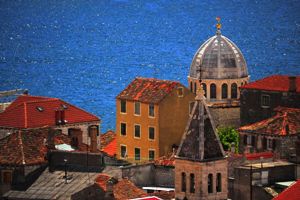We were based in Sibenik for a few days, it’s a smashing little town half way between Zadar and Split – historic and quaint, with narrow streets opening into shady squares, shops with mysterious opening times, cosy cafes and bars, and an astonishing church, the Cathedral of St James, so magnificent that it is actually a UNESCO World Heritage Site, one of only 7 in Croatia. Made entirely from stone from the nearby island of Brac, it took over a hundred years to build and it’s notable for the line of heads all around the outside, just above head height – these stone faces are said to be those of the local residents of the time, some are angry, some cheerful, all realistic. http://whc.unesco.org/en/list/963/video
Right at the top of the hill above the town is the fortress of St Michael, that obviously must have been rather inadequate as a defence as like most other Dalmatian towns Sibenik was conquered over the centuries by the Italians, the Venetians, the Hungarians, the Austrians and the Germans.
Although the beach at our hotel was lovely we went out on day trips too. One drive took us to Primosten, once an island and now joined to the mainland by a short causeway – as you arrive in the wide town square you can see ahead a narrow winding lane with ramshackle cottages and huts that takes you up to the church at the top of the hill. Surrounding the church is the graveyard, each resident has a superb almost 360 degree view of the sea and the coast – the best views are saved for eternity!
 We didn’t have time to go to Plitvice Lakes, it would have been a good two hours each way on the motorway, but we did go instead to Krka National Park, a couple of miles from Sibenik and which is also famous for its lakes and waterfalls – equally spectacular. There are 17 waterfalls here, and you can follow the wooden pathway to admire the pools and cascades, and take a boat trip on the Krka River. There is a second National Park close to Sibenik, the Kornati Islands – you can see the odd shapes and wild slopes of the 140 islands stretching into the distance from the town.
We didn’t have time to go to Plitvice Lakes, it would have been a good two hours each way on the motorway, but we did go instead to Krka National Park, a couple of miles from Sibenik and which is also famous for its lakes and waterfalls – equally spectacular. There are 17 waterfalls here, and you can follow the wooden pathway to admire the pools and cascades, and take a boat trip on the Krka River. There is a second National Park close to Sibenik, the Kornati Islands – you can see the odd shapes and wild slopes of the 140 islands stretching into the distance from the town.
We met a very energetic and inspiring man at Dubrava Falconry Centre (sokolarski), which cares for all injured or sick birds of prey in the region. He worked as a printer who came to Dalmatia in search of fresh air instead of poisonous ink fumes, and has stayed to rescue these magnificent endangered birds such as buzzards, eagle owls and others from all over the country. They are treated and if possible rehabilitated here – some of the more damaged birds stay however, and can be seen at close quarters and on displays. The founder speaks excellent English and is clearly passionate about his work – his presentation of the birds was memorable and thoroughly entertaining.
On our travels around Sibenik we called in at a couple of family-run farms-cum-bed and breakfast-cum-wine growers out in the middle of nowhere. One was Konoba Dabar at Danilo which serves hearty Dalmatian food and wine and offers comfortable accommodation, and at Kalpic Agrotourism at Radonic there are romantic old cottage rooms as well as good local wines. We also ate well and were well-entertained at Ethnoland, a recreation of a traditional Croatian village of old stone farmhouses and workshops, and with a vivid description of the customs and costumes of days gone by.
If you would like to book a private day trip to any of these places from Sibenik, Zadar or Split with your own guide, car and driver, please email Tara@ReadyClickAndGo.com for expert advice on a great day tour in Croatia and a tailormade itinerary.











